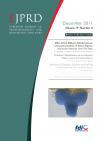European Journal of Prosthodontics and Restorative Dentistry
Evaluation of Sorption, Solubility and Staining of Universal and Silorane Resin-Based Composites
Abstract
Abstract - Resin-based composite staining is a multifactorial phenomenon and can be caused by intrinsic and extrinsic factors. The purpose of this study was to compare staining, sorption and solubility of silorane resin-based and universal resin-based composites. Five different resin-based composites (4 Seasons, Charisma, Filtek Silorane, Filtek Supreme and Grandio) were tested. Twenty five specimens were prepared (10 mm diameter and 1.5 mm thick). To staining test, the specimens were divided into 3 groups (n=5): distilled water (control), coffee and red wine. The specimens were immersed in one of the solutions at 37ºC for 7 days. Using the values of L*, a*, b*, color variation (CIEDE2000) was determined. For sorption and solubility test, the specimens were divided into 2 groups (n=5): with previous desiccation (Group 1) and with no previous desiccation (Group 2). The methodology used for sorption and solubility test was based on ISO 4049:2000. The results presented no significant difference in staining between composites. In sorption and solubility test, Filtek Silorane presented the smallest values, followed by Grandio. Under tested experimental conditions, it is not possible to assert the dependence of staining in sorption that composites are undergone. There was no significant correlation between colour change and sorption values.
KEYWORDS: resin-based composite, sorption, discoloration
IntRodUCtIon
Resin-based composite is extensively used in dentistry as an aesthetic restorative material. The success of an aesthetic restoration depends on the correct choice of shade and the color stability of the material. Colour stability is an important factor for aesthetic restoration longevity. Resin-based composite staining is a multifactorial phenomenon and can be caused by intrinsic and extrinsic factors. Internal colour changes depend on the composite photoinitiator system1-3. Intrinsic discoloration is permanent and is related to polymer quality, type and quantity of inorganic filler and type of accelerator added to the photoinitiator system4 . Extrinsic factors include staining through the adsorption and/or absorption of colorants, as a result of external sources of contamination2. Extrinsic staining depends on the individual’s diet, hygiene and the chemical properties of the composite. Composition and volume of organic matrix, type and volume of filler particles, type of fillermatrix silanization and polishing are relevant factors in the composite susceptibility to staining5, 6. Currently, replacement of restorations is the main reason for performing direct restorations. Discoloration of the material is one of the main reasons for replacing aesthetic restorations7-12. Thus, researches about the properties of the composite related to staining is important to understand the process of color change and for the improvement of the restorative material.
Resin-based composite restorations are not stable after polymerization and constantly interact with the environment 13. In the oral environment, composites absorb water and chemical substances and release components into the environment 14, 15. Sorption in resin-based composite is a diffusion-controlled process that causes chemical degradation due to monomer release and filler-polymeric matrix debonding16, 17. The phenomena of sorption and solubility may serve as precursors to various physical and chemical properties that can produce deleterious effects on the structure and function of the polymeric material18, 19 . Various factors related to chemistry and structure of the polymeric networks are important in determining the extent to which the material will be affected by the aqueous environment. Chemical characteristics include hydrophilicity of the polymer and differences between the solubility parameters of the polymer and the solvent. Important structural parameters include the cross-linking density and porosity of the polymer network 19, 20. There is a hypothesis that staining is related to water sorption21, 22. The most recent commercial composite are silorane resinbased. Some authors23, 24 relate that this material is stable in aqueous environment. The experimental hypothesis was that if silorane resin-based composite presents low water sorption, it should be more color stable. The purpose of this study was to compare staining, sorption and solubility of silorane resin-based and universal resin-based composites.
MatERIalS and MEthodS
Specimen Preparation
In this study 5 different resin-based composites were tested (table 1). Twenty five specimens were prepared in a Teflon mold, 10 mm in diameter and 1.5 mm thick. A glass micro-
* DDS, Ms † DDS, PhD
Authors
T.E. de Almeida Anfe, C.M. Agra, G.F. Vieira
Articles from this issue
 Free Access
Free Access No Access
No Access Full Access
Full Access


